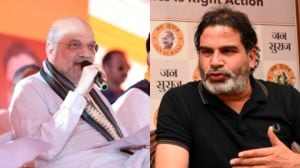At Churchgate, India boards a Mumbai train
Look at Punjabi woman writing Ram Naam, listen to the snore from behind the burka

As usual, it’s an entire country in a railway compartment.
There’s a south Indian matriarch combing her frizzy hair, two Gujarati hausfraus swapping recipes at full volume, an incognito woman in a black burka snoring gently, a prostitute from Kamathipura in a bright orange salwar kameez and matching lipstick, a Punjabi lady industriously writing her Ram Naam in a dog-eared notebook, and a Maharashtrian stenographer chopping carrots into a little plastic bag for dinner. Sisters and strangers, united by the journey of Life on a Mumbai train.
At the far end, I spy three teenagers, ethnically unidentifiable in jeans and tee-shirts. They are haggling for two rupee hairclips with a grimy, five-year-old vendor wearing a discarded party frock—and a smile worth a million bucks.
At the door is the sentry: an old beggar with stumps for legs, the only male permitted in this jealously guarded female bogey. Beyond the chicken mesh that respectably separates the “leddies logh” from male eyes, you can hear a standing Bhajan Group, noisily praising the Lord to the steady clash of cymbals, and the clackety-clack of train wheels.
Seated next to them is the Patta gang, deftly sorting their decks on briefcase-top card tables. And, at the rain-drenched window, the Dalal Street set argues amiably with the diamond merchants’ clique, on the relative merits of Reliance versus Infosys. Obviously, it’s something they have argued about for years.
But things aren’t quite this civilized before departure.
When the empty Virar Fast pulls slowly into Churchgate Station at peak hour today, it is seized, captured and annexed by 5,000 edgy predators, desperately preying on less than 2,000 seats.
Push, shove, nudge, hoot. You know how it is in the urban jungle: only the fittest survive. Regular pass-holders are grudgingly awarded the prime window seats, like regal lions after the kill. Other scavengers settle for less plum positions next to crowded gangways. And the meek inherit the exits until they are disgorged at their destinations. Then, almost miraculously, when the ranks have settled and the wheels start to click, competition turns to camaraderie, and belligerence to amiable chit-chat. (Hey, what’s a little squabbling between friends?)
It’s a muggy, malodorous, asphyxiating ride on a 60-km track that cleaves through the island of Mumbai, like a knife slicing through a piquant chilli. The heavily barred windows are secured with chicken mesh, the smell of rusting iron seeps into your skin, the seats are hard and unforgiving, and the grating fans try valiantly to stir the stale air.
No frills here, just the bare bones of civil amenities, minus the bare basics of human dignity. And yet, like thousands of my fellow citizens, I love these tired old trolleys that hurtle through good times and bad. The reason is simple.
Mumbai’s trains connect me with my country, both literally and figuratively. They are India in microcosm, diverse, yet united by aspiration. Competitive, yet strangely contented.
Aggressive, yet accepting. Parochial, yet secular. Chaotic, yet orderly. Crowded and shabby, but intent on racing into the future on the engine of Hope. It is this precious hope that the bombs have tried to destroy. And that is precisely why Mumbai’s trains must never stop running—and will never stop running.



- 01
- 02
- 03
- 04
- 05




























